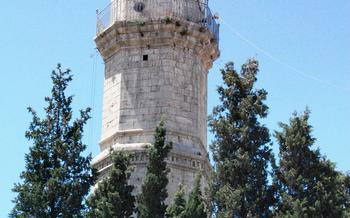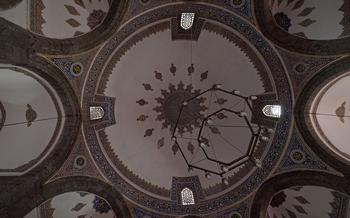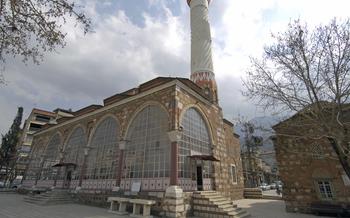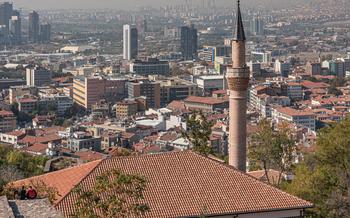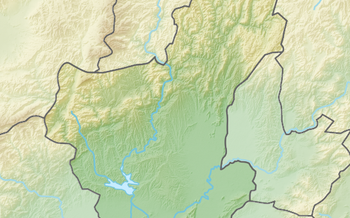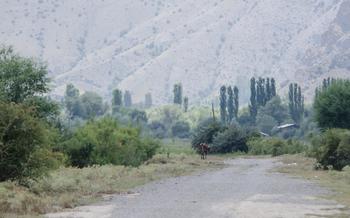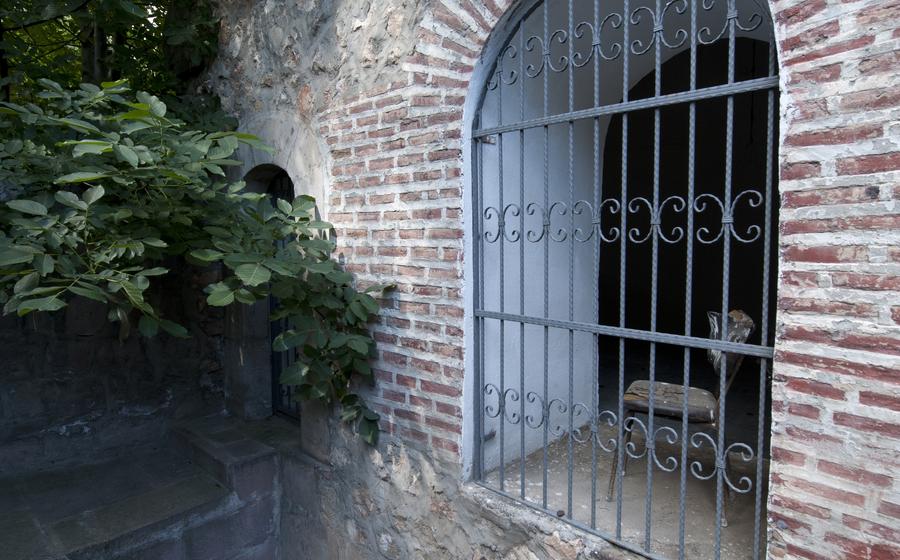
Cami i Kebir Mosque
- Historical Significance
- Architectural Marvel
- Prayer Hall
- Courtyard
- Dome and Minarets
- Carpets and Rugs
- Qibla Wall
- Minaret
- Visiting Etiquette
- Photography and Videography
- Local Customs and Traditions
- Local Festivals and Events
- Historical Context
- Restoration and Preservation
- Insider Tip:
Historical Significance
The Cami i Kebir Mosque in Tokat, Turkey, is a remarkable architectural marvel that holds immense historical significance. Built in the 12th century during the Seljuk period, the mosque stands as a testament to the rich architectural heritage of Tokat. It is one of the oldest mosques in Turkey and is considered a prominent landmark in the city, attracting visitors and worshippers alike. The mosque's cultural and religious importance is deeply intertwined with the local community, as it has served as a central place of worship and community gathering for centuries. Its enduring presence and historical significance make it a must-visit destination for anyone interested in exploring the cultural and architectural legacy of Tokat.
Architectural Marvel
The Cami i Kebir Mosque stands as a testament to the architectural prowess of the Seljuk and Ottoman periods. Its unique style blends the grandeur of Seljuk architecture with the elegance of Ottoman design, creating a harmonious ensemble that captivates the eye. The mosque's exterior is adorned with intricate stone carvings, each panel telling a story from Islamic history and culture. The graceful domes, supported by elegant columns, add to the mosque's majestic presence. The minarets, reaching towards the heavens, are a symbol of the mosque's spiritual significance and serve as a reminder of the call to prayer that echoes through the city five times a day. The mosque's design reflects the artistic and cultural influences of its time, showcasing the convergence of different architectural traditions in Tokat.
Prayer Hall
The prayer hall of the Cami i Kebir Mosque is a breathtaking sight, spanning a vast expanse with elegant interiors that inspire awe and tranquility. The grandeur of the hall is enhanced by intricate designs and calligraphy adorning the walls and ceiling, creating a mesmerizing visual spectacle. The space exudes a palpable spiritual atmosphere, inviting worshippers to immerse themselves in prayer and contemplation. The serene ambiance of the prayer hall fosters a deep connection with the divine, making it a sanctuary for spiritual seekers and a testament to the mosque's religious significance.
Courtyard
The courtyard of the Cami i Kebir Mosque serves as a serene and tranquil space, inviting visitors to pause and reflect amidst the bustling surroundings of Tokat. Enclosed by graceful arched walkways, the courtyard exudes a sense of serenity and peace, offering a respite from the vibrant city life. At its center, a water fountain provides a soothing ambiance, its gentle murmur adding to the tranquility of the space.
In Islamic architecture, the courtyard holds significant functional and aesthetic value. It serves as a gathering place for the community, providing a space for social interaction, religious discussions, and community events. Additionally, the courtyard's design elements, such as the arched walkways and central fountain, reflect the principles of Islamic architecture, which emphasize harmony, symmetry, and the integration of natural elements.
Dome and Minarets
The dome of the Cami i Kebir Mosque is a remarkable architectural feat, towering over the prayer hall and dominating the mosque's skyline. Its grand size and intricate design reflect the mosque's importance and grandeur. The dome's shape, reminiscent of a half-sphere, symbolizes the heavens and the celestial realm. It is supported by a series of arches and pendentives, creating a sense of lightness and spaciousness within the prayer hall.
The mosque's minarets, slender and elegant, rise from the corners of the building, adding to its visual appeal and symbolic significance. They serve as a reminder of the mosque's role as a place of worship, inviting the faithful to prayer. The minarets are adorned with intricate carvings and tilework, showcasing the artistry and craftsmanship of the mosque's builders.
Together, the dome and minarets form a harmonious ensemble, creating a striking silhouette against the backdrop of the city. They stand as symbols of Tokat's rich architectural heritage and the enduring legacy of Islamic architecture in Turkey.
Carpets and Rugs
The Cami i Kebir Mosque is adorned with intricate carpets and rugs, each telling a unique story through its vibrant colors and intricate patterns. These textiles are not merely decorative elements but hold deep cultural and religious significance in Islamic tradition. The carpets and rugs are carefully chosen to create a warm and inviting atmosphere, providing a comfortable space for worshippers to engage in prayer and contemplation.
The designs and patterns woven into these carpets and rugs often draw inspiration from Islamic art and architecture, featuring geometric motifs, floral patterns, and calligraphy. These intricate designs not only enhance the aesthetic appeal of the mosque's interior but also serve as a reminder of the rich artistic heritage of Islamic culture.
Beyond their aesthetic value, the carpets and rugs also play a practical role in creating a conducive environment for prayer. The soft and plush texture provides a comfortable surface for worshippers to kneel and prostrate during their prayers, while the intricate designs help to focus the mind and create a sense of tranquility.
Visitors to the Cami i Kebir Mosque are encouraged to take a moment to appreciate the beauty and significance of the carpets and rugs that adorn its floor. These textiles are not just decorative elements but are an integral part of the mosque's spiritual and cultural identity.
Qibla Wall
The qibla wall of the Cami i Kebir Mosque holds immense religious significance, indicating the direction of Mecca, the holiest city in Islam. During prayer, Muslims face the qibla to align their hearts and minds with the global community of believers. This wall is often adorned with intricate designs, calligraphy, and decorative elements, reflecting the mosque's artistic and cultural heritage. The orientation of the qibla wall is determined through careful astronomical calculations and is essential for maintaining the unity and directionality of prayer. The presence of the qibla wall serves as a constant reminder of the mosque's role as a spiritual center and a place of connection with the wider Islamic world.
Minaret
The mosque's minaret is a prominent feature that adds to its architectural grandeur. Standing tall, the minaret serves as a beacon, guiding the faithful to the mosque and calling them to prayer. Its slender form tapers gracefully towards the sky, creating a striking visual against the backdrop of the city. The minaret is adorned with intricate carvings and patterns, showcasing the artistry and craftsmanship of its builders. From its summit, the muezzin's call to prayer resonates through the neighborhood, inviting the community to join in the spiritual journey. The minaret not only serves a functional purpose but also embodies the religious and cultural significance of the mosque, symbolizing the connection between the earthly realm and the divine.
Visiting Etiquette
When visiting the Cami i Kebir Mosque, it is important to observe proper etiquette to show respect for the religious significance of the site. Visitors should dress modestly, with shoulders and knees covered, and avoid wearing revealing or tight clothing. Upon entering the mosque, it is customary to remove one's shoes and place them neatly on the designated racks. Maintaining silence and refraining from loud conversations or disruptive behavior is essential to preserve the tranquil atmosphere of the mosque. Visitors should also be mindful of not blocking the passageways or disturbing worshippers during prayer times. Guided tours are often available, providing valuable insights into the mosque's history and architecture. Visitors are encouraged to inquire about tour availability and timings to enhance their understanding and appreciation of this sacred space.
Photography and Videography
Respecting the sanctity of the Cami i Kebir Mosque is paramount when it comes to photography and videography. Before capturing any images or videos, it is essential to seek permission from the mosque's authorities. This not only shows respect for the religious space but also ensures that you are not violating any rules or regulations.
When taking photos or videos, be mindful of your surroundings and avoid disturbing worshippers or disrupting the serene atmosphere of the mosque. It is advisable to use a tripod to minimize camera shake and avoid using flash photography, which can be disruptive and disrespectful.
While capturing the mosque's architectural beauty and grandeur, remember to focus on details that showcase its unique features, such as the intricate carvings, colorful tiles, and stunning calligraphy. Wide-angle shots can provide a panoramic view of the mosque's interior or exterior, while close-ups can highlight specific elements that often go unnoticed.
By following these guidelines, you can capture meaningful and respectful images of the Cami i Kebir Mosque that will serve as lasting memories of your visit to this sacred site.
Local Customs and Traditions
Visiting the Cami i Kebir Mosque involves respecting local customs and traditions to ensure a positive and enriching experience. Before entering the mosque, visitors should remove their shoes and maintain silence out of respect for the sacred space. Women are expected to cover their heads and shoulders, while men should dress modestly. Attending prayers or participating in religious ceremonies is permitted, but visitors should observe the customs and etiquette followed by the local community. These practices hold cultural significance and play a vital role in preserving the traditions and customs of Tokat. Engaging with the locals, asking questions, and showing interest in their culture can lead to meaningful interactions and a deeper understanding of the mosque's significance beyond its architectural beauty.
Local Festivals and Events
The Cami i Kebir Mosque is not only a place of worship but also a venue for various local festivals and events that hold deep cultural and religious significance for the community. One of the most notable events is the annual Mevlid-i Nebi, which celebrates the birth of Prophet Muhammad. During this festival, the mosque becomes a center of festivities, adorned with colorful decorations and vibrant energy. Locals gather to offer prayers, recite praises, and participate in communal meals, fostering a sense of unity and spiritual renewal. Other events may include religious ceremonies, Quran recitals, and educational seminars, all contributing to the mosque's role as a hub for Islamic learning and cultural preservation. For visitors, attending these events offers a unique opportunity to immerse themselves in the local customs, traditions, and the vibrant religious life of Tokat.
Historical Context
The Cami i Kebir Mosque stands as a testament to the rich history and cultural heritage of Tokat. Its construction in the 12th century during the Seljuk period reflects the region's architectural and cultural transformation under the Seljuk dynasty. The mosque's design embodies the fusion of Seljuk and Ottoman architectural styles, showcasing the evolution of Islamic architecture over the centuries.
Built during a period of prosperity and growth for the Seljuk Empire, the mosque served as a symbol of the dynasty's power and influence. Its strategic location within the city center underscores its significance as a religious and communal hub for the local population. The mosque's construction also coincided with the rise of Tokat as a major trading center, attracting merchants and travelers from across the region.
The Cami i Kebir Mosque stands as a tangible reminder of Tokat's rich past, reflecting the city's role as a crossroads of cultures and a center of Islamic learning and devotion. Its enduring legacy continues to inspire awe and reverence among visitors, offering a glimpse into the vibrant history of this ancient city.
Restoration and Preservation
The Cami i Kebir Mosque has undergone several restoration and preservation efforts throughout its history. In the early 20th century, the mosque's dome and minarets were repaired and strengthened to ensure their structural integrity. In the 1970s, a comprehensive restoration project was undertaken, which involved cleaning and repairing the mosque's exterior and interior, as well as restoring the intricate stone carvings and decorative elements.
Preserving such historical landmarks is of utmost importance, as they represent a tangible connection to the past and a valuable cultural heritage. However, this endeavor is not without its challenges. The main challenge lies in balancing the need for preservation with the need for adaptation to modern-day requirements. The mosque, while primarily a religious space, also serves as a popular tourist attraction, and modifications may be necessary to accommodate the needs of visitors while maintaining the sanctity of the site.
Ongoing projects and initiatives are focused on protecting and promoting the mosque's heritage. The local government, in collaboration with cultural heritage organizations, is actively involved in preserving the mosque's architectural features and ensuring its long-term sustainability. These efforts include regular maintenance, restoration work, and educational programs to raise awareness about the mosque's historical and cultural significance.
Insider Tip:
For a truly immersive experience, plan your visit to coincide with one of the mosque's regular prayer times. Witnessing the faithful gathered in solemn devotion, their voices rising in unison, is a moving testament to the spiritual significance of this sacred space. As you stand among them, enveloped in the collective energy and tranquility, you'll gain a deeper understanding of the mosque's role as a beacon of faith and community in Tokat. Respectful observation is always welcome, and the locals are known for their warm hospitality, so don't hesitate to engage with them and learn more about their traditions and way of life.
